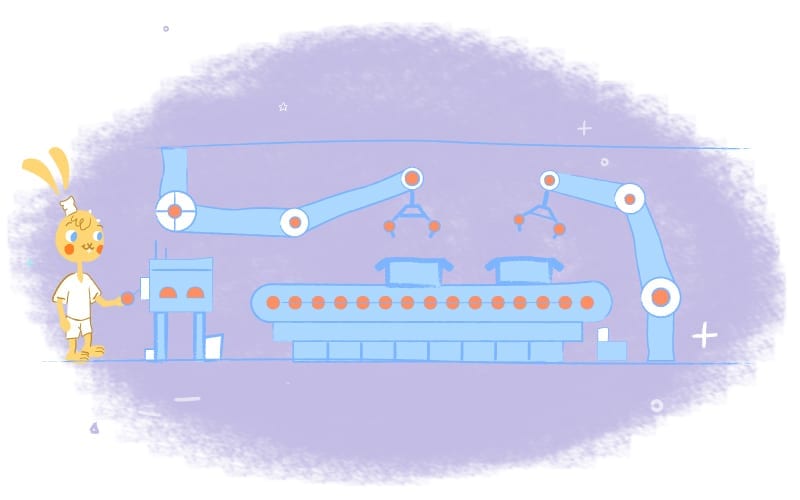

They say old habits die hard, and that’s undoubtedly true in accounting departments. Why implement accounts payable automation when the old manual way works just fine? Even if automation can save your team time for more nuanced, thoughtful work — is it worth throwing out traditional AP processes? Here is how to free up your accounting team’s time in three steps.
That type of thinking is fear of change creeping in. How else can you explain that though more than 80% of B2B operators believe technology can reduce both errors and costs, only 41% of businesses have implemented any form of AP automation?
In most cases, resistance to changing the way things have been done before comes because companies don’t want to mess with a process that seems to be working. In others, they fear they’ll unwittingly invite operational inefficiencies and financial loss into their businesses. All are valid concerns — but at the end of the day, the need for automation will continue to fester if it’s ignored.
What’s Holding You Back from Automating Your Processes?
To be fair, there is some validity to skeptics’ hesitation. After all, automating processes can take a significant amount of time and resources. And, even when the solution is in place, it takes time and effort from employees to commit to changing their day-to-day workflows to accommodate the new system.
For example, let’s say employees are willing to spend hours in training to learn new processes — even working late to make up for lost time. If they’re so burnt out on the latest procedures by the time the technology is implemented, the entire thing will be for nothing. Just as a chain is only as strong as its weakest link, a process is only as strong as the extent to which it’s adopted.
Expenses are another justifiable concern. When there’s already a robust finance headcount, it’s easy to feel that implementing a new solution won’t save much in the long term. Plus, it might seem that applying automation won’t make a big enough difference to justify the cost.
If you can’t directly connect the impact of AP automation to the bottom line, it can be hard to get executives to extend the resources necessary to support the change. Executives are used to approving things with a dollar sign and clear business case, so a vague description of operational efficiencies and empowered employees might not convince them.
Finally, disrupting the status quo is a significant deterrent. This issue arises most frequently in change-management situations. Organizations assume that just because they’ve done something one way for years, that’s the only — and right — way to do it. But this is simply not the case.
Realistically, an organization that adheres to a single static process for such a long time is more of a red flag than a safety net. It means they’ve become stuck in their ways; they only do what they know works rather than opening themselves up to new opportunities and technological advancements.
Some organizations that recognize the challenges of receiving executive buy-in might even balk at the idea of automation from the start and give up altogether. Again, if executives can’t get a dollar amount of savings, they might not sign off on the technology.
Execs (and others) are used to being promised a very quantifiable benefit for the things they approve, so bottom-line efficiencies — which sometimes are primarily qualitative and hard to measure — can be difficult for them to process.
It takes a brave leader to take the onus of developing a business case for AP automation, and the fear of added complications can keep some leaders from even suggesting it as a solution.
The Reality of AP Automation
Although moving to an AP automation system indeed calls for an investment of time and money, it’s probably less than you think.
Like any new technology, AP automation tools will take some time to implement, but it will not take any more time than other solutions you’ve achieved. Most platforms will designate a customer success advocate who can guide you and your team through the transition and minimize the disruption to your business. And like the other solutions in your tech stack, what you’ll save — from both a time and cost perspective — will make the upfront investment more than worth it.
Your suppliers will be quick to get on board as well. Although you might worry that suppliers will be reluctant to automated invoices, it’s more likely that they already receive them from many other businesses. Besides this, it benefits them, too: Automating invoice processing can shave more than 80% off processing costs and speed up the cycle by 73%.
Invoice processing is a crucial part of AP operations, but automating it will streamline tax, onboarding, and other financial processes as well. It might even elevate your business operations as a whole by giving you new insights into complex data. When you can track your spending carefully and accurately, you’ll be able to identify financial problems before they happen. And with that advance warning, you’ll have the chance to change course and lower your risks.
Commit to Automation or Get Left Behind
Although some seasoned executives might drag their feet when it comes to AP automation, the reality is that they must either commit to technology or decide they’re okay with being left in the dust of their competitors.
Automation is becoming an essential element of the AP process — not because it competes with human accounting teams, but because it elevates them. AP automation frees your team from basic, monotonous tasks so that they can focus on more strategic projects that require more in-depth analysis.
Before, accountants might have spent their time begrudgingly hunting down small ledger discrepancies. Now, a system can quickly scan for those errors and correct them (not to mention help prevent them in the first place).
Also, AP processing continues to become more complex, meaning automation can save even more of your team’s time in the future. As AP departments receive more supplier invoices electronically, it’s vital that they can drop these invoices into a similarly automatized digital system to maintain efficiency. The more a company can adopt cloud-based solutions, the better, as this type of data storage saves time, paper, and operational churn.
The Larger the Business, the Bigger the Bills
As an organization grows, so does its expenditures. But growing companies have more to contend with than just the invoice process.
Company growth impacts the entire supplier process, including onboarding, tax identity collection, invoice management, and payments. Today, 88% of businesses expect to eliminate at least 25% of their paper invoices in the next three years. That means it’s imperative for businesses to automate their operations in a way that strengthens financial controls, streamlines the reconciliation process, and regulates supplier churn.
Because AP involves direct access to cash, proper governance is crucial. To help protect your company’s cash, look for solutions that offer role-based permissions. That way, you can better oversee and enforce the separation of duties by only giving employees access to the information that’s needed to do their jobs. For instance, you can set specific rules for completing initiative disbursements, funding accounts, developing approval workflows, and creating reports.
Any AP solution you choose should let you configure specific approvals for both invoices and payments. It should also include user and supplier audit trails, reporting, and document storage so that you’re ready for an audit at a moment’s notice.
Once again, if you try to account for these various business needs with different solutions, it will only cause more work for you in the future as you streamline retroactively. It’s much easier to choose one solution from the start that accommodates all these different needs in an efficient, nonduplicative way.
If your business is global, you must take into account the added complexities of payments that cross borders. With more than 26,000 global payment rules, 140 payment methods (such as prepaid debit cards, international automated clearinghouses, and wire transfers), and increased scrutiny from tax and regulatory bodies, global companies have their work cut out for them.
Automation helps because very single invoice must be reconciled with its specific payment order, or your business could face cash flow shortfalls and inaccurate profitability forecasts.
How to Assess the AP Solutions Landscape
Even though there are myriad reasons to automate AP processes — it’s the way of the future. When you automate your systems, it empowers your team to allocate their time more strategically. Remember, it’s imperative for overall business efficiency to automate your processes. Even understanding all those benefits won’t make it any easier to assess precisely which solutions are best for your organization.
There is no lack of product options on the market, but many of the choices offer precise solutions to very nuanced problems. How can you identify one that will help you in all areas of your accounting department in a way that genuinely streamlines your business?
These strategies will help you understand your options and evaluate which automated solution is best for your organization.
1. Find a solution that scales with your business.
As your business grows in size, you can no longer rely on antiquated AP methods and processes. These older processes are simply not adequate for increasing operational demands.
The right tool will facilitate payments across many entities and foreign exchanges, as well as high-volume mass payments and international payments. There are plenty of scalable, smart solutions out there — but most only address one or two facets of invoice-to-payment reconciliation. That is nowhere near enough. Your solution must be both comprehensive and scalable.
Look for a single platform that automates and standardizes everything from invoice capture and approvals to payments and reconciliation. Otherwise, you will make the common mistake of thinking you’re saving money by implementing one-off, cost-effective “solutions” that end up being duplicative and inefficient or leave gaps in processes with no oversight. In that case, you’ll find yourself with expensive implementation bills, a half-baked product, and overworked employees.
2. Streamline more than just invoices.
Automation for AP should be about more than invoicing. Yes — invoicing is an extraordinarily time-consuming and monotonous process. Still, your technology solution should also streamline onboarding, tax, and other financial processes.
By letting your automation technology parse payments and remit them in the appropriate format, you will save your staff time that they can reallocate to more strategic tasks. For example, your team might be spending tedious chunks of time receiving, processing, and remitting checks. The antiquated process isn’t fun, and it takes an extraordinary amount of time and attention to detail.
Your automation tool should be able to instantly record, reconcile, and upload payment status and data for each payment method. Without manual tasks on its plate, your AP team can take more time to analyze data, identify trends, and help leaders make strategic business decisions.
3. Get detailed insights into your financials.
In a world dominated by big data, the ability to review it, analyze it appropriately, and make the necessary process changes is extremely rare. However, the best AP automation tools do provide valuable insights into complex data. And as a result, you can track spending, identify financial problems before they occur, mitigate risk, and improve reconciliation.
If you learn how to pivot effectively based on your data analyses, your business will grow in exponential ways. Maybe there’s an untapped opportunity with an industry that is particularly lucrative to you. Perhaps there has been a weak link in your processes that has also cost the company thousands of dollars.
Data analysis allows you to not only identify these patterns — which otherwise might have been lost in the shuffle or relegated to strategic planning meetings — but also to act on and implement them.
Look for AP solutions that solve multiple issues — for example, think about your supplier data management, cash flow, invoice data and capture, invoice approval, data entry, approval processes, and audit trails.
Implementing any new business process is a serious undertaking. It requires an investment of time and resources for your entire company, not to mention a commitment to riding out the transition.
But if everyone on your team is willing to work together, automating your AP system will pay dividends in boosting your operational efficiencies and bottom line. If you haven’t thought through these changes already, now is a perfect time.











Chen Amit
Chen Amit is the co-founder and CEO of Tipalti, a payment automation software that helps businesses manage their entire supplier payments operations by streamlining all phases of the AP and payment management workflow.